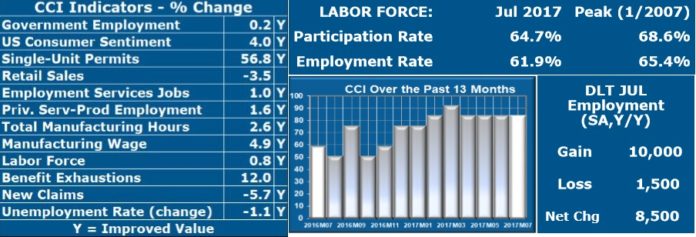
SOUTH KINGSTOWN – Positivity heralds the start of the second half of 2017, said University of Rhode Island economist Leonard Lardaro in the latest Current Conditions Index chronicling the state’s performance.
His report found the state economy measured an 83 for the fourth month in a row in July. A CCI reading greater than 50 suggests economic growth and a value less than 50 indicates contraction.
In July, Providence Business News reported the state’s unemployment rate as 4.3 percent – a 0.1 percent increase from June and a 1.1 percent dip from the 5.4 percent of July 2016.
The July CCI report reflects a 25-point increase year-over-year, which continues the trend that sees positive gains for every month of 2017 over its 2016 counterpart. Lardaro said the continued year-over-year improvement was “a feat that hasn’t occurred for a very long time,” noting the year-over-year spread in measurements has increased in the past three months.
Ten of the 12 CCI indicators saw improvements in the July 2017 report.
Since the beginning of 2007, said Lardaro, the state’s labor force has “displayed a well-defined down trend … a train wreck,” but has turned around in recent months. In July it realized a 0.8 percent increase – its fifth consecutive gain.
In its ninth consecutive increase, U.S. consumer sentiment saw a 4 percent bump in July.
Trends in employment service jobs previously “concerned” Lardaro, but the 1 percent rise in July “is potentially very encouraging,” he said.
Single unit permits (56.8 percent), reflective of new home construction, and total manufacturing hours (2.6 percent) – both goods-producing indicators – grew in July. The manufacturing wage was bumped up by 4.9 percent in July.
Increases were also seen in government employment (0.2 percent), private service-producing employment (1.6 percent) and benefit exhaustions (12 percent).
New claims, an indicator of pending layoffs, fell 5.7 percent in July – its seventh such drop in the past nine months.
In its first tumble since February 2017, retail sales dropped by 3.5 percent in July.
Emily Gowdey-Backus is a staff writer for PBN. You can follow her on Twitter @FlashGowdey or contact her via email, gowdey-backus@pbn.com.










